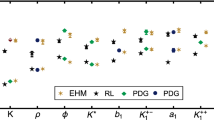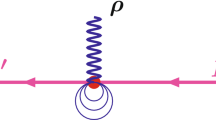Abstract
The connection between field-theoretic equations based on the Bogolyubov–Medvedev–Polivanov and Lehman–Szymanczyk–Zimmerman \(S\)-matrix methods is discussed [1]. These equations are used to derive three-dimensional time-ordered relativistic Lippmann–Schwinger-type equations for hadronic collision amplitudes with and without quark degrees of freedom [2, 3]. Quark degrees of freedom are considered following the Huang–Weldon approach [4], in which hadrons are considered as bound states of quarks. Numerical solutions of the obtained equations made it possible to describe well the experimental phase shifts of elastic \(\pi N\) and \(NN\) scattering in the low-energy region. Using a separable approximation, a quark–parton model for inclusive production of particles with a large transverse momentum was reproduced [6]. This made it possible to describe the experimental data of inclusive production of a \(\rho \) meson with a large transverse momentum (≤1.5 GeV/c) in a proton–proton collision in the energy region 2.9 ≤ \(\sqrt s \) ≤ 64 GeV [5].
Similar content being viewed by others
Notes
This region is defined by the conditions \(P \gg \sqrt {{{Q}^{2}}} \) and \({{Q}^{2}} \gg {\mathbf{k}}_{T}^{2}\), where \(k = (\sqrt {m_{V}^{2} + {{{\mathbf{k}}}^{2}}} ,{\mathbf{k}})\); \({{{\mathbf{k}}}_{Z}}\), and \({{{\mathbf{k}}}_{T}}\) denote the four-momentum and the longitudinal and transverse momenta of the meson, respectively.
In the separable approximation, each sufficiently smooth function \(f(x,y)\) can be represented in the form \(f(x,y)\) = \(\sum\nolimits_m {{{g}_{m}}(x){{{\tilde {g}}}_{m}}(y)} \) with arbitrary accuracy. In practical calculations, usually, \(m = 1\,\,{\text{or}}\,\,2\).
REFERENCES
N. N. Bogolyubov, A. A. Logunov, A. I. Oksak, and A. I. Todorov, General Principles of Quantum Field Theory (Nauka, Moscow, 1987) [in Russian].
A. I. Machavariani, “Three-dimensional field-theoretical equations for a two-particle system and the problem of \(\pi - N\), \(NN\), and \(q - \overline q \) scattering,” Phys. Part. Nucl. 24, 317–353 (1993).
A. I. Machavariani and A. J. Faessler, “Current conservation and analytic determination of the magnetic moment of the \(\Delta \) resonance in the \(\pi - N\) bremsstrahlung: II. Formulation with quark degrees of freedom. III. Magnetic moment of the Δ° and Δ– resonances,” Phys. G: Nucl. Part. Phys. 38, 035002–035017 (2011).
K. Huang and H. A. Weldon, “Bound state wave functions and bound state scattering in relativistic scattering theory,” Phys. Rev. D 11, 257–277 (1975).
A. I. Machavariani, “On the \({{\rho }^{o}}\)-meson production in the inclusive proton-proton collision,” arXiv: 1712.06395v2.
A. I. Machavariani (in press).
Author information
Authors and Affiliations
Corresponding author
Additional information
Translated by E. Chernokozhin
Rights and permissions
About this article
Cite this article
Machavariani, A. Bogolyubov–Medvedev–Polivanov S-matrix Method and Its Application to Multi-Particle Systems and in High-Energy Physics. Phys. Part. Nuclei 51, 572–577 (2020). https://doi.org/10.1134/S1063779620040474
Received:
Revised:
Accepted:
Published:
Issue Date:
DOI: https://doi.org/10.1134/S1063779620040474




